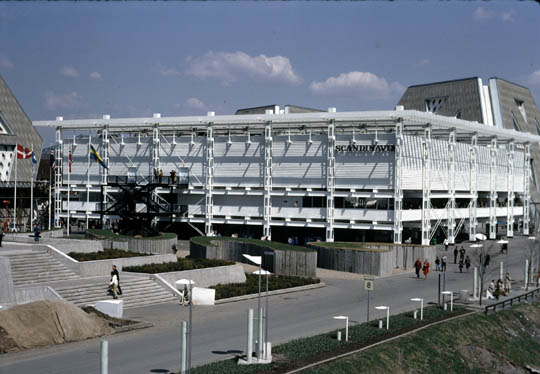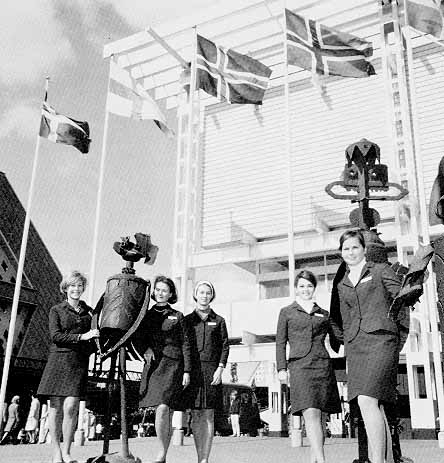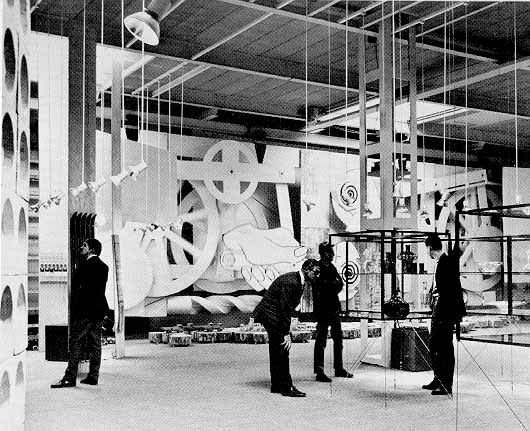Scandinavia Pavilion

| The Scandinavia pavilion. Photo by Bill Dutfield. |
The pavilion, designed by five architects, one from each country, was a rectangular white building that stood on steel legs above an open court. The building was clean, neat and functional in the beat tradition of Scandinavian design. It used steel from Sweden, plastic skylights from Denmark, laminated wood beams from Finland, dark slate from Norway, and colored textiles from Iceland.

| Five countries, Denmark, Norway, Sweden, Finland and Iceland took part in the Scandinavia pavilion. |
Denmark
Denmark's section of the pavilion seemed almost empty until the visitor became aware of large abstract spatial sculptures floating in mid-air but suspended from the ceiling. The sculpture's industrial components represented historical development, agriculture, industry, arts, crafts and science in Denmark.Finland
Finland's space in the pavilion was a five panel spectacular exhibit called "Creative Finland." Each panel, measuring 430 square feet, was made of either ceramics, metal, textiles, glass or wood. Industrial photographs of each of its industries was displayed behind each panel. Artist Timo Sapaneva's panel for the glass industry, consisted of 600 individually designed and blown glass sculptures ranging in color from translucent white to a pale rose. Six ceramic swans, blue, black and white, cut a glittering yellow wake across a still lake of deep blue in the second panel.Another panel representing the metal industry was a glowing abstraction of copper. Called Sun on the Fells, it showed craters, swelling mountains and valleys, literally dynamited out of the metal. The fourth panel, a tapestry of more than 300 shades and 660,000 individual pieces of thick yarn, gave the verdant, protected feeling of Finland's green woodlands. And the Forest and Paper industries was evoked by the final panel. The artist used sculptured wood to suggest the whirlpools and eddies of a mighty river.
Iceland
Iceland showed how it tamed the power of volcanic energy to provide heat and energy for Iceland's 200,000 people. The exhibits showed how Icelanders succeeded in harnessing their "subterranean fire" to heat homes, water and greenhouses, thus creating one of the few modern societies with no air pollution problem. Drawings, cutaway models, photographs and ceramics made of lava were all employed in the exhibit.Photographs by Rafn Halnfjord told the history of the Icelanders whose country was settled by Vikings in 870 A.D. and the story of their explorations and achievements.
Norway
A fifteen foot high sculptured steel waterfall, tumbling in abstract shapes into a pool of gleaming metal, set the spirit of Norway's area within the pavilion. Vertically, water represented the hydroelectricity that powered Norway's metallurgical and chemical industries. Horizontally it pointed to ties with the sea, and the role of Norwegians as explorers, ship-builders and fishermen.The main wall of the "Man and Water" area concentrated on the romance of Norway's ties with the sea. There was a reproduction of a rock carving of a Viking ship and, recessed in it, exhibit cases containing models of little trawlers, freighters and whalers. Hanging above the section was a replica of the 900 A.D. Oseberg Viking ship, and adjacent a modern 14 foot high figure head.

| The pavilion's Swedish exhibits include Per Olof Utvedt's kinetic sculpture. |
Sweden
The focal point of Sweden's portion of the pavilion is an eight minute film that is projected on a screen which suddenly appears behind Per Olof Utvedt's kinetic sculpture. With clanks and whirrings, the two gigantic hands started to move the vast wrenches; its huge bolts began to turn and the white sculpture formed by the hands, bolts, and wrenches, split down the middle. The film presented a quick, witty impression of Swedish life. The story is simple - Swedes were trying to make their country the world's most pleasant, most human place to live.With industry the basis of the intent, the surrounding displays accentuated the point. Displayed were a lifebuoy, rock drills, a propeller, a grand piano, delicate ceramics and the housewares for which Swedish designers are renowned.